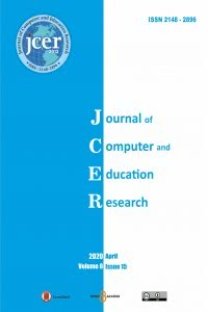LİSE ÖĞRENCİLERİNİN VERİ ANALİZİNDE BAĞLAM BİLGİLERİ İLE MATEMATİKSEL/İSTATİSTİKSEL BİLGİLERİNİ KULLANIM ŞEKİLLERİ
Bağlam bilgisi, istatistik eğitiminde önemli bir bileşen olarak görülmesine rağmen bu alanda yapılan çalışmalar oldukça azdır. Bu çalışmada veri analizinde öğrencilerin bağlam bilgisini nasıl kullandıkları belirlenmeye çalışılmıştır. Bu amaçla iki veri grubunun karşılaştırılmasına yönelik üç sorudan oluşan veri toplama aracı geliştirilmiş ve Trabzon’da öğrenim gören toplam 120 on birinci sınıf öğrencisine uygulanmıştır. Öğrencilerin yazılı olarak verdiği cevaplar, verilerin yorumlanmasında matematiksel/istatistiksel bilgileri ile bağlam bilgileri arasındaki ilişkinin incelenmesi amacıyla ele alınmıştır. Elde edilen bulgular öğrencilerin çoğunluğunun sadece bağlamsal bilgileri ya da sadece matematiksel-istatistiksel bilgileri kullandıklarını göstermektedir. Her iki düşünme biçimini bir arada kullanan öğrenci cevaplarının ise oldukça az olduğu sonucuna varılmıştır. Bu kapsamda her bir kategoriye yönelik öğrencilerin akıl yürütme şekilleri ayrıntılı olarak sunulmuştur.
Anahtar Kelimeler:
İstatistiksel Düşünme, Bağlam Bilgisi, İstatistik Eğitimi, Lise Öğrencileri
Use of High School Students’ Context and Mathematical/Statistical Knowledge Forms in Analyzing Data
Context knowledge is identified as an important component in statistical education but research in this area is very limited. In this study was tried to determine how students use the context knowledge in data analysis. With this aim, a performance test on data analyzing was developed. This performance test is include three questions for comparing the two data sets. The performance test was applied to total 120 students studying at six different 11th grade classes of two high school in Trabzon during 2012–2013 academic year. Students’ responses were analysed using Dapueto ve Parenti (1999) Model. Results showed that context knowledge is the most widely used form of reasoning in statistical task. Only the use of mathematical and statistical knowledge was just as much as the use of context knowledge. Both mathematical-statistical and context knowledge were quite a few of the answers that reflect the way of thinking. Forms of reasoning of students in each category are presented in detail.
___
- Australian Education Council (1991). A national statement on mathematics for Australian schools. Melbourne: Author.
- Australian Education Council (1994). Mathematics: A curriculum profile for Australian schools Carlton, VIC: Curriculum Corporation.
- American Statistical Association, (2005). Guidelines for assessment and instruction in statistics education college report. http://www.amstat.org/education/gaise/
- Berg, C. A. & Phillips, D. G. (1994). An investigation of the relationship between logical thinking structures and the ability to construct and interpret line graphs. Journal of Research in Science Teaching, 31, 323-344.
- Bernstein, B. (1996). Pedagogy, symbolic control and identity: Theory, Research, Critique. London: Taylor&Francis.
- Cooper, B. & Dunne, M. (2000). Assessing children’s Mathematical Knowledge: Social Class, Sex And Problem Solving. Buckingham, UK: Open University Press.
- Çepni, (2008). Kuramdan Uygulamaya Fen ve Teknoloji Öğretimi (7.Baskı).Ankara: Pegem A yayınları.
- Dapueto, C. & Parenti, L. (1999) Contributions and obstacles of contexts in the development of mathematical knowledge. Educational Studies in Mathematics, 39, 1-21
- Gal, I. (2002). Adult statistical literacy: Meanings, components, responsibilities. International Statistical Review, 70(1), 1-25.
- Gal, I. (2004) Adult’s statistical literacy: Meaning, components, responsibilities In D Ben-Zvi & J Garfield (Eds ), The challenge of developing statistical literacy, reasoning, and thinking (47-78) Dordrecht: Kluwer.
- Garfield, J., & Ben-Zvi, D. (2007). Developing Students’ Statistical Reasoning: Connecting Research and Teaching Practice. Emeryville, CA: Key College Publishing.
- Langrall, C., Mooney, E., Williams, N. (2005). Students' use of context knowledge in interpreting data. Proceedings of the 28th annual conference of the Mathematics Education Research Group of Australia.
- Langrall, C., Nisbet, S. & Mooney, E. (2006). The interplay between students’ statistical knowledge and context knowledge in analyzing data. In A. Rossman and B. Chance (Eds.), Proceedings of the Seventh International Conference on Teaching Statistics, Salvador, Brazil. Voorburg: The Netherlands: International Statistical Institute.
- Milli Eğitim Bakanlığı (2005). İlköğretim Matematik Dersi 6-8. Sınıflar Öğretim Programı. T.C. Milli Eğitim Bakanlığı, Talim ve Terbiye Kurulu Başkanlığı. Ankara.
- Mevarech, Z. R. & Kramarsky, B. (1997) From verbal descriptions to graphic representations: Stability and change in students’ alternative conceptions. Educational Studies in Mathematics, 32, 229-263.
- Miles, M B , & Huberman, A M (1994) Qualitative Data Thousand Oaks, CA: Sage.
- Mooney, E., Langrall, C., & Nisbet, S. (2006). Developing a model to describe the use of context knowledge in data explorations. In A. Rossman and B. Chance (Eds.), Proceedings of the Seventh International Conference on Teaching Statistics, Salvador, Brazil. Voorburg: The Netherlands: International Statistical Institute.
- Moore, D. (1990). Uncertainty In L Steen (Ed ), On the shoulders of giants: New approaches to numeracy (95-137) Washington, D C : National Academy Pres.
- National Council of Teachers of Mathematics (2000). Principles and Standards for School Mathematics. Reston, VA: Author.
- Nisbet, S., Langrall, C., & Mooney, E. (2007). The role of context in students' analysis of data. Australian Primary Mathematics Classroom, 12 (1), 16-22. www.eric.ed.gov/PDFS/EJ793971.pdf
- Nunes, T., Schliemann, A. D., Carraher, D. W. (1993). Street Mathematicians And School Mathematics. Cambridge: Cambridge University Press.
- Pfannkuch, M. & Wild, C. (2004) Towards an understanding of statistical thinking In D Ben-Zvi & J Garfield (Eds ), The Challenge of Developing Statistical Literacy, Reasoning, and Thinking (17-47) Dordrecht: Kluwer.
- Watson, J. & Callingham, R. (2003). Statistical literacy: A complex hierarchical construct. Statistics Education Research Journal, 2, 3-46.
- Watson J. M. (2006). Statistical Literacy at School, Growth and Goal. Mahwah, NJ: Lawrence Erlbaum Associates, Publishers. Londan.
- Yayın Aralığı: Yılda 2 Sayı
- Başlangıç: 2013
- Yayıncı: Tamer KUTLUCA
Sayıdaki Diğer Makaleler
FEN BİLGİSİ ÖĞRETMEN ADAYLARI GÜNLÜKLERİNİN YANSITICI DÜŞÜNME YETENEKLERİNE GÖRE İNCELENMESİ
Ufuk TÖMAN, Sabiha ODABAŞI ÇİMER
PERGEL-CETVEL VE DİNAMİK BİR YAZILIM KULLANIMININ BAŞARIYA ETKİLERİNİN KARŞILAŞTIRILMASI
Ümit AKAR, Mihriban HACISALİHOĞLU KARADENİZ
Bilişim Teknolojileri Rehber Öğretmenlerinin Bilgisayar Etiğine İlişkin Görüşleri
Güzide ÖNER, İbrahim YILDIRIM, Mehmet BARS
VIEWS OF INFORMATION TECHNOLGIES GUIDE TEACHERS WITH REGARD TO COMPUTER ETHICS
Güzide ÖNER, İbrahim YILDIRIM, Mehmet BARS
LİSANSÜSTÜ EĞİTİM GÖREN ÖĞRENCİLERİN ÖZERK ÖĞRENME BECERİLERİNE İLİŞKİN ALGILARI
